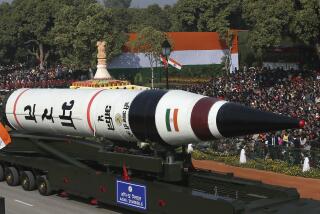India’s Testing: Something Doesn’t Fit
- Share via
As one colleague said of India’s resumed nuclear testing in the Rajasthan desert, “Something doesn’t fit.”
There is an inconsistency between what India announced and what outside scientists have been able to detect, and what nuclear designers in the United States are willing to credit.
India claims to have exploded three nuclear devices on May 11. If all three bombs were detonated simultaneously, as India’s prime minister says they were, then the seismic signal should have measured the total yield of all three devices. Typical fission weapon yields are around 20 kilotons to 40 kilotons; a first generation thermonuclear or hydrogen bomb should have a yield of at least half a million tons of TNT.
The energy release measured outside of India was certainly not more than 100 kilotons, and very likely far less. Credible estimates range from 25 kilotons to 80 kilotons. Indian scientists claim that they detonated a true two-stage hydrogen bomb with a yield of 43 kilotons, a 12-kiloton fission device and a 600-ton battlefield nuclear weapon. This is a total explosive yield of about 56 kilotons, which would agree with the seismic data.
It is difficult but not impossible to accept the Indian statement that their hydrogen bomb was deliberately kept to 43 kilotons to avoid disturbing local inhabitants. If so, this shows good working knowledge of the principles of hydrogen bombs. It could even indicate that the device is small enough to mount on a ballistic missile. If the device was successful at low yield, it probably can be scaled up to truly enormous yields.
The second round of tests, on May 13, pose an interesting puzzle as claimed. India says that they were also “low yield” and intended to allow Indian scientists to obtain enough data to perform computer simulations of nuclear explosions. They must have been very low yield, indeed, for the seismic record is consistent with no tests having occurred.
However, it is extremely difficult to make a nuclear device that has reliably and predictably small yields. One must start and stop the chain reaction with incredible precision. The techniques for making such devices have not, so far as I know, ever been leaked. One must either credit Indian scientists with extraordinary skills and confidence, given that they had only conducted one weapons test before the present series. Or one must believe that they did not know what the yields of their “small” devices would be. The latter is more probable.
It also is conceivable that the tests occurred only as a press release and not in the field.
India said in Sunday’s press conference that those “low yield” tests had been conducted “in a sand dune.” If so, that is a worldwide first and raises serious questions about Indian responsibility regarding the venting of radioactive debris to the atmosphere. A sand dune is porous and would not retain the radioactive gases produced in the explosion. Sand dunes have no tensile strength and an unexpectedly large explosion might blow a hole to the surface.
First-time tests with small devices frequently are unpredictable. Taking such an environmental risk is inconsistent with the spirit of the Limited Test Ban Treaty, to which India is a party.
Indian defense specialists and the prime minister have declared India a nuclear power. They have spoken of targeting doctrine, flexible response, assured penetration of cruise and ballistic missiles to their targets, of hardened launch sites and invulnerable command centers. In short, India has begun to walk the dark one-way corridor of a nuclear arms race. Each nuclear power must do the same, and each proceeds alone.
Once a nation relies on unambiguous nuclear deterrence for its security, there is no way to retreat. No nuclear power will grant it immunity from nuclear attack nor come to its nuclear defense. Despite present rhetoric in New Delhi about total nuclear disarmament, when faced with dismantling its nuclear stockpile and without impossible-to-obtain absolute guarantees that its adversaries have destroyed theirs, Indian leaders will hang on to their weapons. There will be no total nuclear disarmament on the Indian subcontinent. The same applies to Pakistan, as will U.S. sanctions, which are automatic, if it conducts a nuclear test. India has lost its nuclear virginity; welcome to the real world.
More to Read
Sign up for Essential California
The most important California stories and recommendations in your inbox every morning.
You may occasionally receive promotional content from the Los Angeles Times.










